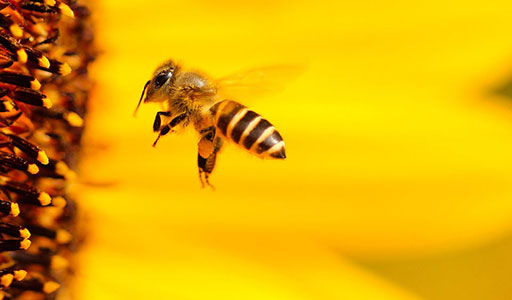Bee Removal
Do you need to get rid of bees? We can help!

Bee Removal Strategies
Bees are some of the oldest living organisms, their history dating back millions of years. Today, there are about 4,000 species in the United States alone. Although often seen as pests, these stinging insects play an important role in keeping plant and crop populations healthy. In fact, bees sustain modern farming by pollinating about one-third of all U.S. crops. However, those that build their colonies on, near, or inside homes and buildings can cause problems for homeowners.
Bee Problem

Signs Bees are on Your Property
Most of the time you’ll notice bees either on flowering plants around your property or you’ll hear them if they’re inside. If you hear humming sounds in your walls or attic you’ve likely discovered a bee nest.

Dangers of Bee Infestation
Frequently, bees build nests where people congregate, such as decks and patios. This can be problematic, since roughly 2 million Americans are allergic to bee stings. In fact, severe anaphylactic reactions contribute to the deaths of over 100 people in the U.S. each year. Cosmetic damage to wood where hives have been built is also common. Additionally, nests can be hard to reach and dangerous to remove, as any attempt at relocation will upset the bees inside. In some cases, the pests release pheromones in order to swarm together and attack common enemies.
Humane Bee Removal & Control Strategies

Entry into property
Homeowners may want to identify potential entry points for bees in the spring. During this mating season, large numbers of bees are actively seeking places safe from rain, wind, and predators to build hives. Consequently, they may take advantage of tiny cracks under doors or in foundations.

Trapping & Removal
Bees are helpful insects, pollinating plants that society has come to depend on. For this reason, extermination isn’t recommended. Simple home remedies, like placing open containers of mothballs or vinegar around infested attics or barns, may help to discourage them. However, getting rid of bees without removing their nests is not enough, as hives may get moldy and attract rats. Additionally, bees often take up residence in abandoned nests, so putting off removal may lead to future infestations. For safe and reliable bee control, call the trained professionals at Trutech.

Prevention & Exclusion
Although people without bee allergies can survive many stings, homeowners should still take steps to prevent the insects from swarming around the house. Remove sources of standing water, such as buckets and bird feeders, as bees collect this water to cool down the hive. Likewise, cover swimming pools when not in use. To prevent entry into homes, seal small cracks in walls, foundations, or roofs and make sure chimneys are covered properly. Block drains, attic vents, and irrigation valve boxes with screens or fine wire mesh.
Frequently Asked Questions
Honey bees are not typically aggressive unless they are Africanized. Other species are often misidentified as bees, such as yellow jackets. Regardless, we will identify the culprits and give you the options necessary to get them gone.
While bees are a huge source of anxiety for many people, most are not typically aggressive to people. If someone in your family has an allergy to the sting, than perhaps the removal of the bushes could be warranted. I would first suggest a visit from one of our technicians to determine the species of bee and make sure the problem isn’t manifesting from inside the walls or attic of your home. If it is determined that there is a nest or colony in the vicinity, the tech will give you options for removal.
Removing the entire comb is always recommended, but not always feasible. We will inspect the area and determine the feasibility of removal and let you know our plan. Sometimes we can open up the soffit, scrape it out, and replace the soffit vents. We are sometimes able to remove it from the attic. Other times require cutting it out through the roof, the ceiling, or from the wall outside. If none of these options work for the situation, then we offer a stinging insect prevention program whereby we treat the void every two months to prevent other bees from colonizing the area. This option doesn’t remove the comb that is already there, but it prevents the comb from growing.


